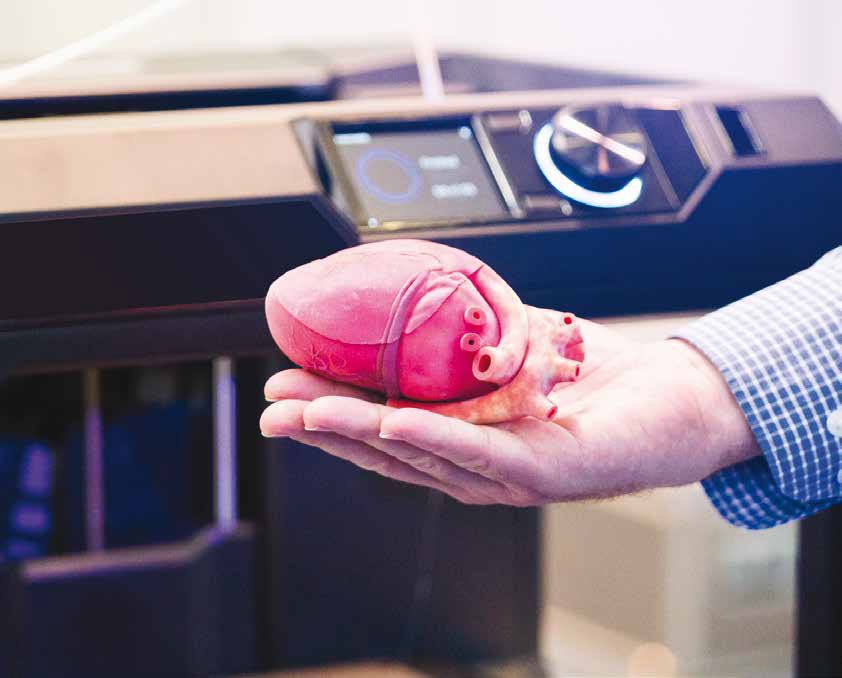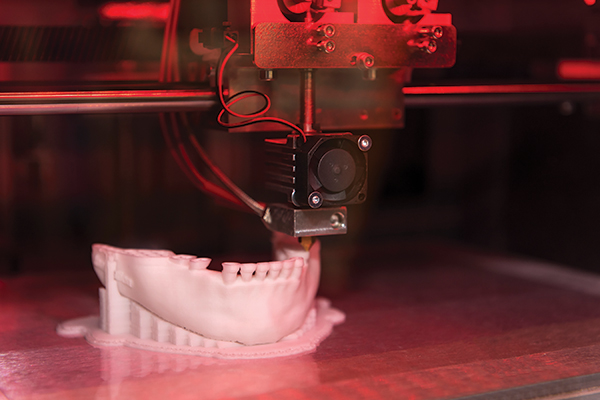3D manufacturing carves out a niche in the pharmaceutical industry While it’s hard to foresee the wholesale replacement of current tablet manufacturing processes, 3D technology creates the opportunity for precise deposition of niche medications and personalise tablets. This article will explore potential areas of application, including orphan drugs (those created for rare diseases), early phase drug development and testing. It will discuss the role of 3D manufacturing in moving treatment away from a one-size-fits-all approach and towards personalisation. It will also cover the different types of 3D printing technology and the benefits and limitations of each as they relate to pharmaceutical manufacturing.
Pharmaceutical manufacturers and consumers alike can look forward to a rapid evolution in the way medicine is manufactured and brought to market. New possibilities in 3D printing are opening doors for both pharmaceutical research and applications such as personalised drug dosing, complex drug release profiles and even bio printing. The implications are enormous: imagine an elderly relative being able to take a slew of medications in one personalised pill, or contemplate 3D printing a life-saving lung to be used in a transplant for a cystic fibrosis patient.
While it is unlikely that current pharmaceutical manufacturing processes will ever be entirely replaced with 3D printing, the technology certainly has vast potential for application in both the pharmaceutical and medical device industries. In fact, research company MarketsandMarkets.com estimates that the use of 3D printing for medical devices alone could reach a market value of US$2.13 billion just two years from now.1
Fuelling this market is increasing global demand. The world’s quickly ageing population has drastically impacted both markets and the industries in which they operate, presenting new challenges--and opportunities--for manufacturers.
Solutions fuelled by 3D printing and other innovations will be on display at Healthcare Packaging EXPO, co-located with PACK EXPO International (Oct. 14-17, 2018; McCormick Place, Chicago).
3D printing technology has improved drastically over the past thirty years. Its foundation, stereolithography, was invented in 1983 by Charles Hull2. The technology converts photopolymers from liquid to solid form following the introduction of ultraviolet light. This light, in the form of a laser, traces a defined area based on a design, creating a tangible, physical object. Stereolithography is the seed of 3D printing, but it has taken decades to develop the technology as we know it today.

3D printing uses an additive process whereby successive layers are applied based on a three-dimensional digital model. Traditional methods of manufacturing rely on subtractive methods such as moulding and casting.
Today, new applications for 3D printing are rapidly emerging. The technology is already being used to manufacture artificial limbs, hearing aids, orthodontics and dental implants, and for pharmaceutical tablet manufacturing. As 3D printing continues to expand across both consumer and industrial sectors, regulations will need to be established, but the impact of this technology will be prolific across both the medical device and pharmaceutical industries.
In 2015, Aprecia Pharmaceuticals achieved the first tablet manufactured through 3D printing to be approved by the U.S. Food & Drug Administration (FDA).The drug, called Spritam, is a reformulation of the anti-epileptic seizure medication levetriracetam. Using 3D printing technology, Aprecia created a highly porous structure for Spirtam, which could not be achieved with traditional manufacturing3. This structure causes the pill to dissolve in seconds upon contact with water, helping both elderly and young patients suffering with trouble swallowing pills, known at dysphagia.
This innovative development was achieved through a proprietary powder bed and inkjet 3D printing technology known as ZipDose. The process begins with a powdered layer that contains the drug. That first layer passes under an inkjet print head and a binding liquid is printed at specified locations along the powdered sheet. Successive layers are then printed up to 40 times, depending on the size of the tablet. Printing the layers allows the drug to be packed more tightly. A single tablet that would normally hold 200 mg can be layered to hold 1,000 mg. The result is a high-dose medicine that is easy to swallow for epileptic patients.
As pharmaceuticals become more personalised, demand for patient-specific solutions is increasing. According to a whitepaper by PMMI, The Association for Packaging and Processing Technologies, the pharmaceutical industry is being transformed by a new emphasis on personalised care. The whitepaper, entitled The Top 5 ForcesShaping the Pharmaceutical and Medical Device Industries in 20174, notes the industry is witnessing a decline of blockbuster drugs, along with explosive growth in biologics and growing use of generics.
Vision for 3D printing in pharmaceuticals is that medication will be customised to an individual’s needs, increasing both safety and efficacy. The size, dose, appearance and rate of delivery of a drug can be designed for each patient. One can imagine a situation in which a tablet for a child is printed into the shape of a cartoon character with the dosage customised to the child’s specific biology. The possibility even exists of layering different medications into one pill to reduce confusion for elderly patients and those that may have to take numerous medications over the course of a day.
Today, once a drug has finished clinical trial requirements and met all regulatory approvals, the dosage options that are brought to market are either one-sizefits-all, or based on key factors such as organ function, weight and age. However, by accounting for genetic variations, a practice called pharmacogenetics, doctors can avoid potential problems, including adverse reactions and lack of response by predicting an optimal dose for individual patients5.
Personalised medicine based on pharmacogenetics is already applied today—albeit on a limited basis. For example, HIV patients are now routinely tested for a genetic variant that would make them more likely to have an adverse reaction to the antiviral drug abacavir (Ziagen)6.
Patients with a trial fibrillation, or irregular heart rates, can also benefit from pharmacogenetics. A genetic test that identifies variations in two specific genes that affect the body’s ability to metabolise Warfarin can be easily administered. Combined with other factors, the test indicates a proper dosage range for the patient, avoiding adverse reactions including uncontrolled bleeding, lifethreatening blood clots, or a potential stroke.
With 3D printing, tablets may be designed to meet the needs of an individual patient identified by genetic testing and printed as needed. Unique drug doses, a combination of drugs and the release profile of the formulation can all be personalised.
3D printing also holds tremendous promise for orphan drugs designed to treat rare diseases that are sometimes not developed by the pharmaceutical industry due to economic reasons. The number of such rare diseases is estimated to be between 4,000 and 5,000 worldwide7. For those patients that are living with a rare disease, the hope and promise of an effective treatment is invaluable. Thankfully, regulations are in place across Asia, Europe and the U.S. to provide incentives for orphan drug research and development. These include tax exemptions, expedited approval and market exclusivity. Such incentives went into effect Japan and in Australia in 1993 and 1997 respectively.
Still, the need for innovation in this space is great, and the inherent flexibility of 3D printing holds tremendous potential for orphan drugs. Bringing a drug to market typically takes around ten to fifteen years and millions of dollars. This is not economically viable for medicines that treat rare diseases, as they only help a small percentage of the population. 3D printing’s ability to rapidly print small batches means that it could serve those who suffer from rare diseases as a means of rapid and more economical drug development.
Aprecia is already putting this concept to the test. In December 2017, the company announced a partnership with Cambridge, UK-based Cycle Pharmaceuticals to develop and commercialise 3D printed tablets for rare diseases8.
The current drug development process is cost-prohibitive and requires years of trial. Part of this is due to the initial stages of the process in which the therapeutic potential of a molecule and its level of toxicity are evaluated9. The rate of failure during this initial stage is high, and therefore pharmaceutical companies must identify and test molecules as quickly and as cheaply as possible. 3D printing can help by expediting the process through speed and flexibility inherent in its ability to produce small batches of drugs with different compositions.
The potential for 3D printing in drug development and testing lies in the ability to rapidly iterate products using flexible, on-demand production for small batches of drugs. Variations in dosage, physical characteristics, and release profiles of drugs could be produced on a small scale for testing.
We have explored the implications of 3D printing in drug trials and personalised medicine, but how might the technology impact the way consumers purchase medicine? The pharmacy of the future could look quite different.

To accommodate an increasing demand for personalisation, pharma manufacturers are adjusting their operations with a focus on faster production speeds, shorter batch runs, specialised packaging and high-value items. As the demands of the market evolve, manufacturers are also evaluating the location of their operations, and many have decided to move production as close to the point of sale as possible.
At the next level, this would mean potentially decentralising pharmaceutical production. With 3D printing, medicines could conceivably be manufactured much closer to patients, perhaps directly in a pharmacy or even in a doctor’s office. On-site, a physician or pharmacist would be able to question the patient regarding factors that could influence dosage decisions.
Instead of storing medicine, pharmacists would simply have each drug’s base product and an encrypted blue print that could be adjusted to suit individual patients’ needs. Medicines could then be printed on the premises.
These developments would certainly amount to an unprecedented level of innovation within all parts of the pharmaceutical industry. Growth and potential at this level does not come without potential roadblocks. There are many questions that have yet to be resolved, but one major issue is the need for regulation.
From serialisation to track and trace technology, today’s pharmaceutical landscape is more heavily regulated than ever before. Considerations for 3D printing include regulation of the printer itself as a medical device, the person operating the machine and all distribution channels. If a drug were to cause an adverse reaction, who would be responsible in a decentralised system?
Questions surrounding potential illegal applications of the technology also exist. Could the ease of production with 3D printing lead to a proliferation of illegal drugs?
The nature of the pharmaceutical industry lends itself to complex regulations, and it will take time to find ways to safely bring advanced applications of 3D printing in this space to market. Still, the potential benefits of this technology are undeniable and the industry should move quickly and cautiously to recognise that potential.
Healthcare Packaging EXPO (Oct. 14-17; McCormick Place, Chicago), co-located with PACK EXPO International, will provide a powerful opportunity for pharmaceutical and medical device manufacturers to converge and address evolving consumer and regulatory demands. Both owned and produced by PMMI, The Association for Packaging and Processing Technologies, the shows will also offer educational programming and opportunities to cross-pollinate ideas among industries.
This year’s show is slated to attract more than 50,000 attendees, including 7,000 international visitors from more than 130 countries. Next generation technology will be on display from the 2,500-plus exhibiting companies spanning 1.2 million net square feet of exhibits.
Attendees across industries will benefit from the Innovation Stage, a series of 30-minute free seminars on technological breakthroughs. Industry specific innovations include updates on trends shaping pharma and medical device companies, coding and serialisation technology, and supply chain visibility among others.
Registration for Healthcare Packaging EXPO, $30 through September 28 and US$100 after, will also include admission to PACK EXPO International for all four days of the show. Register for Healthcare Packaging EXPO today at www.hcpechicago.com.
References:
1 https://www.marketsandmarkets.com/Market-Reports/3dprinting-medical-devices-market-90799911.html
2 https://www.asme.org/wwwasmeorg/media/ResourceFiles/AboutASME/Who We Are/Engineering History/Landmarks/261-Stereolithography.pdf
3 https://www.chemistryworld.com/feature/3d-printing-inpharma/3008804.article
4 The Top 5 ForcesShaping the Pharmaceutical and Medical Device Industriesin 2017
5 https://ghr.nlm.nih.gov/primer/genomicresearch/pharmacogenomics
6 https://www.genome.gov/27530645/faq-about-pharmacogenomics/
7 https://www.orpha.net/consor/cgi-bin/Education_AboutOrphanDrugs.php?lng=EN
8 http://www.cambridgeindependent.co.uk/business/business-news/cycle-pharmaceuticals-to-use-3d-printing-todevelop-orphan-drugs-1-5342956